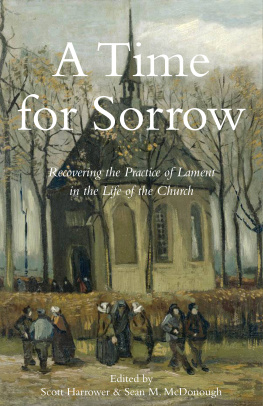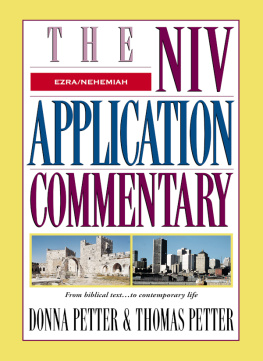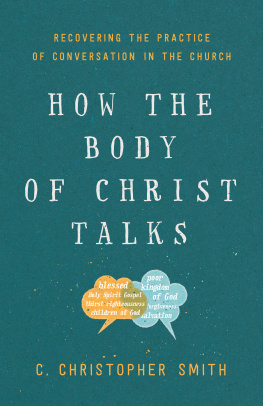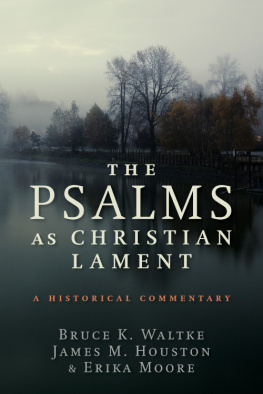A Time for Sorrow: Recovering the Practice of Lament in the Life of the Church (ebook edition)
2019 by Hendrickson Publishers Marketing, LLC
P. O. Box 3473
Peabody, Massachusetts 019613473
www.hendrickson.com
ebook ISBN 978-1-68307-289-8
All rights reserved. No part of this book may be reproduced or transmitted in any form or by any means, electronic or mechanical, including photocopying, recording, or by any information storage and retrieval system, without permission in writing from the publisher.
Scripture quotations marked CSB, are taken from the Holman Christian Standard Bible, Copyright 1999, 2000, 2002, 2003, 2009, 2017 by Holman Bible Publishers. Used by permission. CSB is a federally registered trademark of Holman Bible Publishers.
Scripture quotations marked (ESV) are taken from the Holy Bible, English Standard Version (ESV), copyright 2001 by Crossway, a publishing ministry of Good News Publishers. Used by permission. All rights reserved.
Scripture quotations marked (NIV) are taken from the Holy Bible, New International Version, NIV. Copyright 1973, 1978, 1984, 2011 by Biblica, Inc. Used by permission of Zondervan. All rights reserved worldwide. www.zondervan.com. The NIV and New International Version are trademarks registered in the United States Patent and Trademark Office by Biblica, Inc.
Due to technical issues, this eBook may not contain all of the images or diagrams in the original print edition of the work. In addition, adapting the print edition to the eBook format may require some other layout and feature changes to be made.
First eBook edition November 2019
Cover image:
Vincent van Gogh (185390)
Congregation Leaving the Reformed Church in Nuenen
Nuenen, January February 1884 and autumn 1885
oil on canvas, 41.3 x 32.1 cm
Van Gogh Museum, Amsterdam (Vincent van Gogh Foundation)
s3V1962
F25
Introduction: Why Lament Matters
Sean M. McDonough and Scott Harrower
People want to be happy. It is not surprising, then, that modern churches often seek to create a purely positive, upbeat worship environment. People come to be inspired and uplifted, and they want to leave feeling contented about God, the world, and themselves.
That is the plan, anyway. In reality, of course, the throngs of peppy parishioners still carry around disappointments, grievances, hidden sins, and all manner of physical and emotional troubles. Some of the causes of lament are obvious: the death of a loved one, a painful divorce, a terminal diagnosis. But people can often be ground down toward despair by the gradual wear and tear of everyday life. They feel trapped in a job they hate but cannot give up. Their children seem unable to get the hang of adult life and become a source of perpetual disappointment. They find themselves friendless in a soulless new city. If the gap between the relentless positivity of worship and the unyielding difficulty of life becomes too great, they may simply stop coming to church altogether, under the (often correct) assumption that the church really does not know how to deal with their problems.
The good news is that God offers a different way forward. In addition to the roads of thanksgiving and praise, the Bible acknowledges that Gods people often need to walk the way of lamenta path on which lifes ills can be openly shared with God in the confidence that he is big enough to handle them.
This volume is intended to assist the church in recapturing the biblical practice of lament. Drawing on the major theological disciplinesOld and New Testament studies, church history, and dogmatic and practical theologywe explore the benefits that flow from a faithful approach to God that brings before him all of our lives, not just the positive bits. We will see that the individual and corporate recognition of lifes struggles is fully endorsed by Scripture and should be an integral part of church practice.
The first essay, Lament as a Prayer of Faith by Old Testament professor Lindsay Wilson, serves as an overview of the theme of lament in Scripture, with special emphasis on the need to recapture lament in the contemporary church. Professor Wilsons expertise in Job and the Psalms serves him well as he leads us through the biblical witness on lament.
Another Old Testament scholar, Donna Petter, devotes her attention to the theme of lament in the book of Ezekiel. She delves into the specifics of Ezekiels historical situation and then draws out a critical pastoral point: Lament should not only address situations of personal distress, but it should also give voice to sorrow over sin. Even when the consequences of our sinful choices are unavoidable, a repentant heart is the first step in the restoration God desires for his people.
Rhys Bezzant next offers an historical perspective in his piece Lament among Evangelicals: Historical Reflections on Pastoral Practice. Bezzanta scholar of church history, theology, and Christian worshipdemonstrates that the evangelical churchs ability to properly lament has been hamstrung by a persistent need to pursue social and political power rather than to embrace gospel weakness. As he puts it, There is... in our story an allergic reaction at almost every point to feelings of powerlessness.
Sean McDonough explores Lament in the New Testament. He begins by noting that Old Testament lament texts were very much in play in the early church. He then shows how the call to rejoice in the Lord is balanced by Jesus and the apostles with the acknowledgment of human frailty and the ongoing need to bring our sorrows before the Lord.
Scott Harrower combines biblical exposition with theological reflection in his essay God the Trinity and Christian Care for Those Who Lament. He focuses on the question of divine empathy and action for those recovering from trauma, and the ways in which Gods triune nature serves as a balm to those who have undergone life-shattering experiences. He finds Pauls second letter to the Corinthians to be of particular relevance to victims of trauma.
Finally, Emmett Priceprofessor of worship, church, and culture and founding executive director of the Institute for the Study of the Black Christian Experience at Gordon-Conwell Theological Seminaryexplores the role of lament in congregational life in There Is a Balm in Gilead: A Call to Lament Together. Drawing upon the often unrecognized anguish of the African-American community and other beleaguered peoples, he challenges the church at large to weep with those who weep and embrace the way of lament as the path toward a more just and compassionate body of Christ.
We pray that these essays will be an encouragement to all who care about the progress of Gods kingdom, and who know that its path is often paved with lamentand who also know that while weeping may stay for the night... rejoicing comes in the morning (Ps. 30:5).
1. Lament as a Prayer of Faith
Lindsay Wilson
Introduction: Lament Has Been Neglected in the Christian Church
A popularly held view in Christian circles is that to express lament is necessarily to take up a stance of doubt and unbelief; that verbalizing words of grief to God represents a lack of spiritual maturity rather than being an acceptable, even mandated, response to life in a broken world.
A Filipino friend of mine, Rico Villanueva, has written a small insightful book, Its OK to Be Not OK: The Message of the Lament Psalms . He notes the following in todays churches:
Theres no room for:
- Negative emotions like despair/sadness/loneliness; fear; anger













